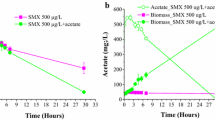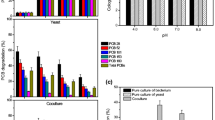Abstract
Two pyrene-degrading strains, Pseudomonas aeruginosa PA06 and Achromobacter sp. AC15 were co-incubated in equal proportions as a microbiological consortium and could enhance the degradation of pyrene. The enzymatic activities of the catechol 1,2-dioxygenase (C12O) and 2,3-dioxygenase activities (C23O) were produced complementary expression by P. aeruginosa PA06 and Achromobacter sp. AC15, respectively. Meanwhile, results showed that pyrene degradation was sufficiently promoted in the presence of sodium citrate as a co-metabolic carbon source, likely a result of enhanced biomass and biosurfactant production. The optimized dosage and ideal initial pHs were 1.4 g L−1 and 5.5, respectively. We also analyzed the rate constant of pyrene degradation, cell growth, and enzyme activity. Results show that P. aeruginosa PA06 had a better effect than Achromobacter sp. AC15 in bacterial growth. However, the C23O or C12O activity produced by Achromobacter sp. AC15 continued at a similar or even faster than that of P. aeruginosa PA06. The mixed bacteria had a better effect than any single bacteria, suggesting the strains worked synergistically to enhance the degradation efficiency. In the co-metabolism system of 600 mg/L pyrene and 1.4 g/L sodium citrate, pyrene degradation reached 74.6%, was 1.57 times, 2.06 times, and 3.89 times that of the mix-culture strains, single PA06 and single AC15 without sodium citrate, respectively. Overall, these findings are valuable as a potential tool for the bioremediation of high-molecular-weight PAHs.







Similar content being viewed by others
References
Amodu OS, Ntwampe SK, Ojumu TV (2019) Improving biodegradation of benzo(Ghi)perylene in soil: Effects of bacterial co-culture, agrowaste and biosurfactant supplementation. Carpathian J Earth Environ Sci 14:191–198. https://doi.org/10.26471/cjees/2019/014/071
Bezza FA, Chirwa EMN (2017) Pyrene biodegradation enhancement potential of lipopeptide biosurfactant produced by Paenibacillus dendritiformis CN5 strain. J Hazard Mater 321:218–227. https://doi.org/10.1016/j.jhazmat.2016.08.035
Cachada A, Pereira R, da Silva EF, Duarte AC (2014) The prediction of PAHs bioavailability in soils using chemical methods: State of the art and future challenges. Sci Total Environ 472:463–480. https://doi.org/10.1016/j.scitotenv.2013.11.038
Chakraborty J, Das S (2016) Characterization of the metabolic pathway and catabolic gene expression in biphenyl degrading marine bacterium Pseudomonas aeruginosa JP-11. Chemosphere 144:1706–1714. https://doi.org/10.1016/j.chemosphere.2015.10.059
Deng MC, Li J, Hong YH et al. (2016) Characterization of a novel biosurfactant produced by marine hydrocarbon-degrading bacterium Achromobacter sp. HZ01. J Appl Microbiol 120:889–HZ899. https://doi.org/10.1111/jam.13065
Dong X, Hong Q, He L et al. (2008) Characterization of phenol-degrading bacterial strains isolated from natural soil. Int Biodeterior Biodegrad 62:257–262. https://doi.org/10.1016/j.ibiod.2008.01.011
Ferrero MA (2015) Improved PAHs removal performance by a defined bacterial consortium of indigenous Pseudomonas and actinobacteria from Patagonia, Argentina. Int Biodeterior Biodegrad 101:23–31
Ghosh I, Jasmine J, Mukherji S (2014) Biodegradation of pyrene by a Pseudomonas aeruginosa strain RS1 isolated from refinery sludge. Bioresour Technol 166:548–558. https://doi.org/10.1016/j.biortech.2014.05.074
Gupta B, Puri S, Thakur IS, Kaur J (2020) Comparative evaluation of growth kinetics for pyrene degradation by Acinetobacter pittii NFL and Enterobacter cloacae BT in the presence of biosurfactant. Bioresource Technology Reports 9. https://doi.org/10.1016/j.biteb.2019.100369
Guzik U, Greń I, Hupert-Kocurek K, Wojcieszyńska D (2011) Catechol 1,2-dioxygenase from the new aromatic compounds–Degrading Pseudomonas putida strain N6. Int Biodeterior Biodegrad 65:504–512. https://doi.org/10.1016/j.ibiod.2011.02.001
Haritash AK, Kaushik CP (2009) Biodegradation aspects of polycyclic aromatic hydrocarbons (PAHs): a review. J Hazard Mater 169:1–15. https://doi.org/10.1016/j.jhazmat.2009.03.137
Heitkamp MA, Franklin W, Cerniglia CE (1988) Microbial metabolism of polycyclic aromatic hydrocarbons: Isolation and characterization of a pyrene-degrading bacterium. Appl Environ Microbiol 54:2549–2555. https://doi.org/10.1128/aem.54.10.2549-2555.1988
Jensen HL (1963) Carbon nutrition of some microorganisms decomposing halogen-substituted aliphatic acids. Acta Agriculturae Scandinavica 13:404–412. https://doi.org/10.1080/00015126309435665
Jiang Y, Zhang Z, Zhang X (2018) Co-biodegradation of pyrene and other PAHs by the bacterium Acinetobacter johnsonii. Ecotoxicol Environ Saf 163:465–470. https://doi.org/10.1016/j.ecoenv.2018.07.065
Jin JN, Yao J, Zhang QY et al. (2015) An integrated approach of bioassay and molecular docking to study the dihydroxylation mechanism of pyrene by naphthalene dioxygenase in Rhodococcus sp. ustb-1. Chemosphere 128:307–313. https://doi.org/10.1016/j.chemosphere.2015.02.012
Joy S, Rahman PKSM, Sharma S (2017) Biosurfactant production and concomitant hydrocarbon degradation potentials of bacteria isolated from extreme and hydrocarbon contaminated environments. Chem Eng J 317:232–241. https://doi.org/10.1016/j.cej.2017.02.054
Kamyabi A, Nouri H, Moghimi H (2018) Characterization of pyrene degradation and metabolite identification by Basidioascus persicus and mineralization enhancement with bacterial-yeast co-culture. Ecotoxicol Environ Saf 163:471–477. https://doi.org/10.1016/j.ecoenv.2018.07.098
Kamyabi A, Nouri H, Moghimi H (2017) Synergistic Effect of Sarocladium sp. and Cryptococcus sp. Co-Culture on Crude Oil Biodegradation and Biosurfactant Production. 324–334. https://doi.org/10.1007/s12010-016-2329-8
Kumari B, Singh DP (2016) A review on multifaceted application of nanoparticles in the field of bioremediation of petroleum hydrocarbons. Ecol Eng 97:98–105. https://doi.org/10.1016/j.ecoleng.2016.08.006
Leadbetter ER, Foster JW (1959) Oxidation products for med from gaseous alkane by the bacterium pseudomonas metharica. Arch Biochem Biophys 82:491–492
Liu T, Zhang Z, Dong W et al. (2017) Bioremediation of PAHs contaminated river sediment by an integrated approach with sequential injection of co-substrate and electron acceptor: Lab-scale study. Environ Pollut 230:413–421. https://doi.org/10.1016/j.envpol.2017.06.063
Ma Y, Lu W, Wan L, Luo N (2015) Elucidation of Fluoranthene Degradative Characteristics in a Newly Isolated Achromobacter xylosoxidans DN002. 1294–1305. https://doi.org/10.1007/s12010-014-1347-7
Mahanty B, Pakshirajan K, Venkata Dasu V (2008) Biodegradation of pyrene by Mycobacterium frederiksbergense in a two-phase partitioning bioreactor system. Bioresour Technol 99:2694–2698. https://doi.org/10.1016/j.biortech.2007.05.042
Mao J, Luo Y, Teng Y, Li Z (2012) Bioremediation of polycyclic aromatic hydrocarbon-contaminated soil by a bacterial consortium and associated microbial community changes. Int Biodeterior Biodegrad 70:141–147. https://doi.org/10.1016/j.ibiod.2012.03.002
Megharaj M, Ramakrishnan B, Venkateswarlu K et al. (2011) Bioremediation approaches for organic pollutants: A critical perspective. Environ Int 37:1362–1375. https://doi.org/10.1016/j.envint.2011.06.003
Mojiri A, Zhou JL, Ohashi A, et al. (2019) Comprehensive review of polycyclic aromatic hydrocarbons in water sources, their effects and treatments. Sci Total Environ 696. https://doi.org/10.1016/j.scitotenv.2019.133971
Muthukamalam S, Sivagangavathi S, Dhrishya D, Sudha Rani S (2017) Characterization of dioxygenases and biosurfactants produced by crude oil degrading soil bacteria. Braz J Microbiol 48:637–647. https://doi.org/10.1016/j.bjm.2017.02.007
Nie M, Nie H, He M et al. (2016) Immobilization of biofilms of Pseudomonas aeruginosa NY3 and their application in the removal of hydrocarbons from highly concentrated oil-containing wastewater on the laboratory scale. J Environ Manag 173:34–40. https://doi.org/10.1016/j.jenvman.2016.02.045
Nzila A (2018a) Biodegradation of high-molecular-weight polycyclic aromatic hydrocarbons under anaerobic conditions: Overview of studies, proposed pathways and future perspectives. Environ Pollut 239:788–802. https://doi.org/10.1016/j.envpol.2018.04.074
Nzila A (2018b) Biodegradation of high-molecular-weight polycyclic aromatic hydrocarbons under anaerobic conditions: Overview of studies, proposed pathways and future perspectives. Environ Pollut 239:788–802. https://doi.org/10.1016/j.envpol.2018.04.074
Nzila A (2013) Update on the co-metabolism of organic pollutants by bacteria. Environ Pollut 178:474–482. https://doi.org/10.1016/j.envpol.2013.03.042
Nzila A, Ramirez CO, Musa MM et al. (2018) Pyrene biodegradation and proteomic analysis in Achromobacter xylosoxidans, PY4 strain. Int Biodeterior Biodegrad 130:40–47. https://doi.org/10.1016/j.ibiod.2018.03.014
Obayori OS, Salam LB, Oyetibo GO et al. (2017) Biodegradation potentials of polyaromatic hydrocarbon (pyrene and phenanthrene) by Proteus mirabilis isolated from an animal charcoal polluted site. Biocatalysis and Agricultural. Biotechnology 12:78–84. https://doi.org/10.1016/j.bcab.2017.09.003
Pazos M, Rosales E, Alcántara T et al. (2010) Decontamination of soils containing PAHs by electroremediation: A review. J Hazard Mater 177:1–11. https://doi.org/10.1016/j.jhazmat.2009.11.055
Petersen DG, Sundbäck K, Larson F, Dahllöf I (2009) Pyrene toxicity is affected by the nutrient status of a marine sediment community: Implications for risk assessment. Aquat Toxicol 95:37–43. https://doi.org/10.1016/j.aquatox.2009.07.023
Qin Z, Zhao Z, Jiao W, et al. (2020) Coupled photocatalytic-bacterial degradation of pyrene: Removal enhancement and bacterial community responses. Environ Res 183. https://doi.org/10.1016/j.envres.2020.109135
Ren G, Teng Y, Ren W et al. (2016) Pyrene dissipation potential varies with soil type and associated bacterial community changes. Soil Biol Biochem 103:71–85. https://doi.org/10.1016/j.soilbio.2016.08.007
Sharma A, Singh SB, Sharma R et al. (2016) Enhanced biodegradation of PAHs by microbial consortium with different amendment and their fate in in-situ condition. J Environ Manag 181:728–736. https://doi.org/10.1016/j.jenvman.2016.08.024
Singh SN, Kumari B, Upadhyay SK et al. (2013) Bacterial degradation of pyrene in minimal salt medium mediated by catechol dioxygenases: enzyme purification and molecular size determination. Bioresour Technol 133:293–300. https://doi.org/10.1016/j.biortech.2013.01.068
Singha LP, Pandey P (2017) Glutathione and glutathione-S-transferase activity in Jatropha curcas in association with pyrene degrader Pseudomonas aeruginosa PDB1 in rhizosphere, for alleviation of stress induced by polyaromatic hydrocarbon for effective rhizoremediation. Ecol Eng 102:422–432. https://doi.org/10.1016/j.ecoleng.2017.02.061
Subashchandrabose SR, Logeshwaran P, Venkateswarlu K et al (2017) Pyrene degradation by Chlorella sp. MM3 in liquid medium and soil slurry: possible role of dihydrolipoamide acetyltransferase in pyrene biodegradation. Algal Res 23:223–232. https://doi.org/10.1016/j.algal.2017.02.010
Swati, Ghosh P, Thakur IS (2019) Biodegradation of pyrene by Pseudomonas sp. ISTPY2 isolated from landfill soil: Process optimisation using Box-Behnken design model. Bioresour Technol Reports 8. https://doi.org/10.1016/j.biteb.2019.100329
Thion C, Cébron A, Beguiristain T, Leyval C (2012) PAH biotransformation and sorption by Fusarium solani and Arthrobacter oxydans isolated from a polluted soil in axenic cultures and mixed co-cultures. Int Biodeterior Biodegrad 68:28–35. https://doi.org/10.1016/j.ibiod.2011.10.012
Thomas F, Lorgeoux C, Faure P et al. (2016) Isolation and substrate screening of polycyclic aromatic hydrocarbon degrading bacteria from soil with long history of contamination. Int Biodeterior Biodegrad 107:1–9. https://doi.org/10.1016/j.ibiod.2015.11.004
Von Lau E, Gan S, Ng HK, Poh PE (2014) Extraction agents for the removal of polycyclic aromatic hydrocarbons (PAHs) from soil in soil washing technologies. Environ Pollut 184:640–649. https://doi.org/10.1016/j.envpol.2013.09.010
Wanapaisan P, Laothamteep N, Vejarano F et al. (2018) Synergistic degradation of pyrene by five culturable bacteria in a mangrove sediment-derived bacterial consortium. J Hazard Mater 342:561–570. https://doi.org/10.1016/j.jhazmat.2017.08.062
Wang B, Teng Y, Xu Y et al. (2018) Effect of mixed soil microbiomes on pyrene removal and the response of the soil microorganisms. Sci Total Environ 640-641:9–17. https://doi.org/10.1016/j.scitotenv.2018.05.290
Wei K, Yin H, Peng H, et al. (2017) Characteristics and proteomic analysis of pyrene degradation by Brevibacillus brevis in liquid medium. Chemosphere 178:80–87. https://doi.org/10.1016/j.chemosphere.2017.03.049
Wen J, Gao D, Zhang B, Liang H (2011) Co-metabolic degradation of pyrene by indigenous white-rot fungus Pseudotrametes gibbosa from the northeast China. Int Biodeterior Biodegrad 65:600–604. https://doi.org/10.1016/j.ibiod.2011.03.003
Zafra G, Taylor TD, Absalón AE, Cortés-Espinosa DV (2016) Comparative metagenomic analysis of PAH degradation in soil by a mixed microbial consortium. J Hazard Mater 318:702–710. https://doi.org/10.1016/j.jhazmat.2016.07.060
Zhang X, Xu D, Zhu C et al. (2012) Isolation and identification of biosurfactant producing and crude oil degrading Pseudomonas aeruginosa strains. Chem Eng J 209:138–146. https://doi.org/10.1016/j.cej.2012.07.110
Zhao F, Shi R, Cui Q et al. (2017) Biosurfactant production under diverse conditions by two kinds of biosurfactant-producing bacteria for microbial enhanced oil recovery. J Pet Sci Eng 157:124–130. https://doi.org/10.1016/j.petrol.2017.07.022
Zhou H, Wang H, Huang Y, Fang T (2016) Characterization of pyrene degradation by halophilic Thalassospira sp. strain TSL5-1 isolated from the coastal soil of Yellow Sea, China. Int Biodeterior Biodegrad 107:62–69. https://doi.org/10.1016/j.ibiod.2015.10.022
Acknowledgements
This study was funded by the Ministry of Science and Technology of China for State Key Research and Development Project (2016YFC0400702); Guangdong Research and Construction of Public Service Abilities (2014B020204004); the Science and Technology Project of Guangzhou, Guangdong Province, China (201607010331); the Department of Science and Technology of Guizhou Province ([2018]4005, [2019]2957, [2020]6001); and the Guizhou Academy of Sciences Fund ([2019]04).
Author information
Authors and Affiliations
Corresponding authors
Ethics declarations
Conflict of interest
The authors declare that they have no conflict of interest.
Additional information
Publisher’s note Springer Nature remains neutral with regard to jurisdictional claims in published maps and institutional affiliations.
Rights and permissions
About this article
Cite this article
Li, J., Chen, W., Zhou, W. et al. Synergistic degradation of pyrene by Pseudomonas aeruginosa PA06 and Achromobacter sp. AC15 with sodium citrate as the co-metabolic carbon source. Ecotoxicology 30, 1487–1498 (2021). https://doi.org/10.1007/s10646-020-02268-3
Accepted:
Published:
Issue Date:
DOI: https://doi.org/10.1007/s10646-020-02268-3




